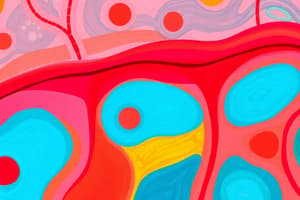Podcast
Questions and Answers
What is the first step in the movement of a drug from administration into the body?
What is the first step in the movement of a drug from administration into the body?
- Absorption (correct)
- Excretion
- Distribution
- Metabolism
What is the purpose of distribution in the movement of a drug?
What is the purpose of distribution in the movement of a drug?
- To store the drug in bodily tissues
- To break down the drug into smaller components
- To eliminate the drug from the body
- To transport the drug to the site of action (correct)
What happens to the drug at the site of action?
What happens to the drug at the site of action?
- It is metabolized into an inactive form
- It interacts with a receptor to produce a response (correct)
- It is stored in bodily tissues
- It is eliminated from the body
What is the process by which the body breaks down a drug into smaller components?
What is the process by which the body breaks down a drug into smaller components?
What is the final step in the movement of a drug from administration into the body?
What is the final step in the movement of a drug from administration into the body?
Flashcards are hidden until you start studying
Study Notes
Absorption and Distribution
- A drug enters the body through administration, which can be oral, parenteral, or topical
- The drug dissolves or disperses in a solvent (such as water or lipid) at the site of administration
- The drug is then absorbed into the bloodstream through diffusion or active transport
- The absorbed drug is distributed throughout the body via the circulatory system
- Drug distribution is influenced by factors such as blood flow, membrane permeability, and protein binding
Metabolism
- The drug is carried to the liver, where it is metabolized by enzymes
- Metabolism involves the conversion of the drug into a more water-soluble metabolite
- The liver is the primary site of metabolism, but other tissues such as the kidneys and lungs can also metabolize drugs
- Metabolism can inactivate the drug, convert it to an active form, or produce toxic compounds
Bioavailability
- Bioavailability refers to the fraction of the administered dose that reaches the systemic circulation
- Bioavailability is affected by factors such as absorption, distribution, and metabolism
Site of Action
- The drug reaches its site of action, where it interacts with target molecules (such as receptors, enzymes, or transporters)
- The drug binds to its target molecule, leading to a response or effect
Elimination
- The drug is eliminated from the body through excretion, which can occur through the kidneys, liver, or lungs
- The kidneys excrete the drug through urine, while the liver excretes the drug through bile
- The drug is eliminated in its original form or as a metabolite
Studying That Suits You
Use AI to generate personalized quizzes and flashcards to suit your learning preferences.




